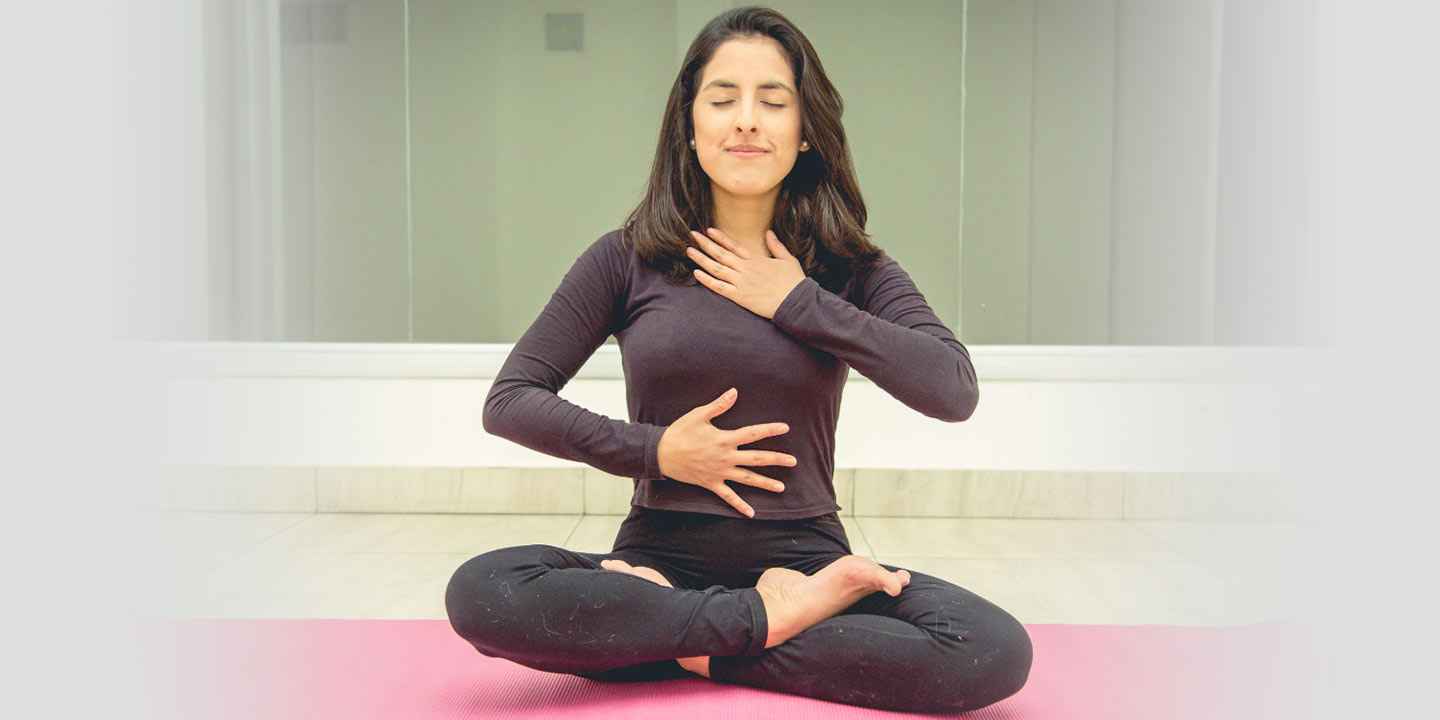Yoga For Thyroid: 11 effective yoga asanas that will help you manage thyroid

Medically Reviewed By
Dr. Ragiinii Sharma
Written By Prekshi Garg
on Nov 15, 2022
Last Edit Made By Prekshi Garg
on Apr 5, 2025

Thyroid disorders affect an estimated 200+ million people globally, and the numbers continually rise yearly. Not only are the numbers alarming, but we also need to understand that these numbers include people officially diagnosed because of their symptoms.
Hundreds and thousands of patients are never diagnosed because they either don’t experience any symptoms or don’t have access to premium healthcare to confirm a diagnosis. As alarming as the condition is, yoga for thyroid is effective in managing the symptoms of multiple thyroid disorders.
This article will explore more about the impacts of yoga on thyroid gland functioning and which ones you should start doing.
Is Yoga Effective for Improving Thyroid Function?
Yoga is often considered a holistic exercise involving your mind, body, and soul. It is ideal for stress management and improving muscle strength and flexibility in the body.
But how effective is yoga asanas for thyroid?
Studies have shown that yoga has promising benefits in relieving the symptoms associated with an overactive and underactive thyroid gland. Not only do they improve thyroid function, but certain yoga poses also promote thyroid hormone regulation.
However, kindly keep in mind that yoga is an alternative healing therapy. It isn’t meant to be a replacement for your medications or an actual doctor’s suggestion. It can be done in conjunction with that to support your thyroid health.
Which Yoga Asanas Improve Thyroid Function?
When choosing different yoga for hypothyroidism and hyperthyroidism, the primary aim is to focus on one thing – throat-stimulating asanas.
Most yoga poses improve blood circulation and energy around the thyroid gland, improving thyroid function.
However, if this is your first time doing yoga to improve and regulate thyroid functions, we recommend doing it under the guidance of a trained professional. Learn the right poses and how to do them before you start doing them independently.
Following are some of the best yoga poses for the thyroid:
1. Supported Shoulderstand
Targets: Spine, Core Muscles, Back of the neck
Benefits: Stimulates thyroid; Calms the brain; Stretches the shoulders and back; Improves digestion.
How to do it?
- Start by laying down a thick and non-slip yoga mat on the ground and lying down on it.
- If required, put a rolled down under your shoulders for support.
- Lay down flat on the mat, keeping your arms beside you, ensuring the palms are faced upwards.
- Inhale and gradually lift your leg until it forms ninety degrees with the ground.
- As you exhale, slowly bring your legs over your head, balancing your feet in the air.
- As you raise your legs towards the ceiling, place your palms on the hip for support.
- Keep your shoulder, spine, and hips in a straight line and your chin tucked into your chest.
- While practicing deep breathing, hold the position for 10-20 seconds and gradually bring your legs back down.
- Release your hold from the hips and lay them by your side.
- Exhale and relax.
- Repeat this 10 times or as per your convenience.
This is one of the best thyroid yoga poses to improve blood flow and circulation around the gland. Ensure that you aren’t pushing yourself too hard or straining the neck.
2. Halasana or Plow Pose
Targets: Spine, hamstring, muscle tension
Benefits: Improves spine flexibility; Improves thyroid function; Relieves constipation.
How to do it?
- Lay down on your yoga mat in the supine position (on your back).
- Place your hands by your side, resting your palms on the ground.
- Gradually, lift both legs in the air, ensuring that you don’t bend your knees.
- Start the lift and hold the legs at 30 degrees, followed by 60 degrees and then 90 degrees.
- As you press down on the ground, slightly lift your hip and buttock as you lower your legs toward the back of your head.
- Touch the ground with your toes on the back of your head and place your palms on the ground beside you.
- Hold this position for 10-30 seconds.
- Repeat this 5-10 times.
If you have a hernia, cervical spondylitis, or any kind of neck injury, avoid doing this yoga.
3. Upward Bow (Wheel) Pose or Urdhva Dhanurasana
Targets: Chest, lungs, arms, wrists, buttocks, legs
Benefits: Stimulates circulation; Improves thyroid function; Expands the lungs; opens chest and abdomen.
How to do it?
- Start with a laying position on the ground. Please ensure that you do it on a thick yoga mat.
- While lying down, bend your knees and spread them hip-width apart. Place your knee right under your knees so they remain parallel to each other.
- Place your palms beside your ear, so they face down on the ground, and your fingers point towards your shoulder.
- Start with an inhale, and then lift your hips, torso, and thighs from the ground on your exhale. Simultaneously, the crown of your head should be touching the ground.
- As you bring your elbows inwards, stretch and arch your middle and lower back.
- As you inhale, press your weight on the feet as you lift yourself further.
- To deepen the posture, inch your feet closer to your hands and make the arch of your back and spine much more prominent.
- Hold this position for 10-30 seconds. Repeat 5-10 times.
While returning to the initial position, be slow and gradual. Avoid putting pressure on the crown of the head.
4. Matsyasana or Fish Pose
Targets: Abdominal muscles, pectoral muscles, neck
Benefits: Improves thyroid function; Relieve muscle tension in the neck, shoulders, and throat.
How to do it?
- Place a yoga mat on the ground and sit on your buttocks
- Keep your legs extended in front and shift on one side to place your palm under your buttocks. Ensure that the palms are face down on the ground for added support.
- Slowly bring your elbows towards each other as you open your chest.
- Lean back your weight into the elbows and forearms.
- As you press into the arms, open your chest as wide as possible.
- Inch and tilt your head backward if needed.
- Release the pose by lifting your head, pulling your palms from under your buttocks, and sitting normally.
- Repeat this 5-10 times.
The strain and exposure to the throat area in this yoga pose improve the thyroid function optimally, making it an effective yoga for hyperthyroidism and hypothyroidism.
5. Janu Shirasana or One-legged Forward Bend
Targets: Hamstrings, hips, groin muscles.
Benefits: Stretches back muscles; Improves thyroid function; Reduces lower back pain.
How to do it?
- Sit down on your buttocks on a yoga mat, keeping your legs extended in front.
- Bend the right knee and place the sole of the foot on the inner thigh.
- As you inhale, lengthen your spine.
- As you exhale, bring your right hand, place your right hand on your left thigh, and place your left hand on your hip.
- Exhale and bend your hips while leaning forward towards your outstretched left leg.
- If you can, reach your arm to touch the left foot.
- Practice deep breathing as you reach your sternum forwards.
- Hold this position for 10-20 seconds and release it as you inhale and exhale.
- Once done, repeat the same on the other side.
Not just does it improve thyroid health, but the yoga pose also relieves fatigue and anxiety in people.
6. Cat-cow Pose or Marjaryasana
Targets: Spine, shoulder, neck
Benefits: Improves posture and balance; Improves thyroid function; Stretches spine and hips.
How to do it?
- Start with a tabletop position, placing your hips and knees straight.
- Place your hands ahead of your shoulders, keeping them at a shoulder-length distance.
- Press down on your palms and exhale.
- As you exhale, round up your spine, curving it towards the ceiling. Simultaneously, drop the tailbone and the crown of your head.
- Broaden your shoulders, and press down firmly on the ground.
- Hold this position for a few seconds and return to the neutral position again.
Thanks to fluid motion, exercise is highly effective in improving thyroid function and supporting the body’s muscle flexibility.
7. Legs up the Wall Pose
Targets: Full body
Benefits: Improve thyroid function; Deep relaxation; Stress relief; Reduced pain.
How to do it?
- If you have pain in the lower back, use a folded towel underneath your hip for support.
- Place the yoga mat, so your right side is against the wall
- Lie down flat on your back on the mat.
- Lift your legs, keeping the wall as a support and reference.
- Lift the legs as much as possible, ensuring that you aren’t excessively stretching the hips and the legs.
- Soften the neck, shoulders, and throat while lifting your legs.
- Place your arms beside you.
- Hold this position for as long as you are comfortable doing it.
Once you feel strain and pain in the legs, return to the original lying position gradually without exerting pressure.
8. Paripurna Navasana or Boat Pose
Targets: Hip flexors, adductors, lower back muscles
Benefits: Strengthens abdominal muscles; Improves balance; Improves thyroid function.
How to do it?
- Sit down on the yoga mat on your buttocks, keeping your legs stretched in front of you.
- Place your hands on the floor, on either side of your upper thigh.
- Lean your upper body back while keeping your spine straight.
- Balance on your buttocks, putting stress on the tailbone.
- Bring your toes up in the air and lift your arms, so they are parallel to the ground.
- Focus on your core muscles as you inhale and exhale deeply.
- Continue balancing in that position for 5-10 seconds.
Once done, return to the original position and repeat the same posture 5-10 times.
9. Bhujangasana or Cobra Pose
Targets: Hamstrings, Gluteus muscles, Spinal extensors
Benefits: Stimulates thyroid, stretches the spine, improves back pain.
How to do it?
- Lay your stomach on a thick yoga mat, placing your palms underneath your shoulders.
- Place your elbows on either side of your chest.
- Gently press down into your palm and lift your head, shoulders, and chest as much as you can as you inhale.
- Bend your elbows slightly to support the posture.
- Hold this position for 5-10 seconds and release it gradually.
This is one of the best yoga asanas to introduce gentle stimulation to the thyroid gland and improve its functions.
10. Ustrasana or Camel Pose
Targets: Thigh, back, abdomen, ankle, throat
Benefits: Improve thyroid function; reduces fat; improve posture.
How to do it?
- Sit down on your knee on a thick yoga mat and place your feet behind you.
- Ensure that your hips, shoulders, and knees are in line.
- Bring your hands back, placing the palm on the hips with the fingers facing down.
- As you stretch your elbows, open your chest.
- Slowly bend your torso back, pressing down on your thighs and hips.
- For comfort, lean your head back as well.
- For extra support, reach your palms and hold on to your ankles.
- Hold this position for 5-10 seconds.
- As you return to the initial position, release your palms and gradually lean forward.
- Repeat this 5-10 times.
This is one of the few thyroid yoga poses that involves deep stretching of the beck to stimulate the thyroid gland and its functions.
11. Savasana or Corpse Pose
Targets: Full body
Benefits: Deep relaxation, Stress relief
How to do it?
- Lay down on the yoga mat on your back, keeping your legs stretched and hip-width apart.
- Extend your arms on either side of your body, keeping the palms facing.
- Ensure that your neck, head, and spine are straight.
- Relax and release all the tension from your body.
- Breathe in and out and relax further.
- If needed, add pillows underneath the shoulders or back for support.
More than impacting the thyroid, the corpse pose allows you to experience full-body relaxation, which is crucial to handle stress.
12. Shishuasana (Child's Pose)
Targets: Lower back, Hips, Thighs, Ankles
Benefits: Reducing tension and fatigue and improving flexibility.
How to Do It:
- Kneel on the floor with your knees hip-width apart and toes together.
- Sit back on your heels and make sure your spine is straight.
- Exhale and bend forward at the hips, extending your arms in front of you.
- Rest your forehead on the mat, feeling a gentle stretch along your back and shoulders.
- Hold this position for several breaths, allowing your body to relax deeper with each exhale.
- To release, gently rise back to a seated position as you inhale.
13. Supta Matsyendrasana (Supine Spinal Twist)
Targets: Spine, digestive organs, and nervous system.
Benefits: Relieves back pain, helps digestion, and relieves constipation-like issues.
How to Do It:
- Lie on your back with extended arms stretched out on the floor, forming a T-shape
- Bring your right knee towards your chest and keep the left leg straight on the floor.
- Using your left hand, gently guide your right knee across your body to the left side, allowing your torso to twist.
- Turn your head to the right, gazing over your right shoulder.
- Ensure both shoulders remain in contact with the floor; it's okay if your right knee doesn't touch the ground.
- Hold the position for 5-10 deep breaths, and feel the stretch along your spine and hips.
- Inhale as you bring your right knee back to the center, then exhale and extend it back to the starting position.
- Bring your left knee towards your chest and perform the twist to the right side.
14. Simhasana (Lion Pose)
Targets: Throat, face, and respiratory system.
Benefits: Reducing stress and relieving symptoms of throat issues
How to Do It:
- Kneel on the floor, crossing your ankles behind you so you sit back on your heels.
- Spread your knees apart.
- Lean forward and place your hands between your knees.
- Inhale deeply through your nose.
- Exhale and open your mouth wide. Stick out your tongue toward your chin and make a "ha" sound.
- At the same time, open your eyes wide and gaze upward between your eyebrows.
- Hold the expression for the duration of the exhale.
- Relax your face as you inhale, and repeat the process 2-3 times.
15. Setu Bandhasana (Bridge Pose)
Targets: Back, glutes, and chest.
Benefits: Strengthens the back and gluteal muscles and improves flexibility.
How to Do It:
- Lie on your back.
- Bend your knees and place your feet on the floor, hip-width apart. Position your arms alongside your body, palms facing down.
- Ensure your feet are about 10-12 inches away from your pelvis, with knees and ankles aligned.
- Inhale and prepare
- Exhale and press your feet to lift your hips toward the ceiling.
- Hold the pose and breathe slowly and deeply.
FAQs
Can yoga cure thyroid disorders permanently?
Yoga poses for thyroid disorders help relieve the symptoms to an extent and promote thyroid function. Only relying on yoga for a cure isn’t recommended.
Can walking cure thyroid?
If you are experiencing thyroid disease symptoms like weight gain, fatigue, and depressive symptoms, walking and exercising can relieve those symptoms but not entirely cure the condition.
Does yoga heal the thyroid gland?
No, yoga has no magical healing properties for your thyroid gland. Instead, it might improve the blood flow and stretch the throat muscles to improve their functions.
Conclusion
The best yoga asanas for the thyroid effectively support your thyroid health and improve your overall functions and symptoms. However, never rely on yoga to replace your standard medical treatment. Yoga is a complementary therapy that works better when taking your medications correctly, following a proper diet, and leading an active lifestyle.



